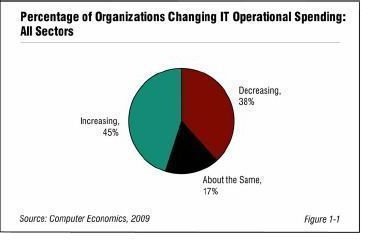Latest Trends in IT Spending Revealed
IT Spending Trend #1: Virtualization
Virtual computer resources are an increasing attraction for IT dollars. Platform, application, and resource virtualization allow many servers to run on a single machine, providing for the consolidation and pooling of resources. IT spending research suggests that this technology has captured the attention of executive and IT management everywhere because of the obvious savings in hardware, power, and space. For example, Purdue University recently took 35 servers, converted them to virtual machines and now runs them on a pool of only five physical machines.
Another feature of virtualization that is propelling its ubiquity is the associated payroll reductions. Fewer machines require fewer administrators, meaning that businesses can shrink payrolls without any degradation in IT performance. With such strong savings associated with it, there’s no surprise that virtualization is at the top of current IT spending trends.
IT Spending Trend #2: Cloud Computing
Now that the cost savings and increased productivity resulting from sharing resources across a corporate cloud or the Internet have been demonstrated, the trend in IT toward cloud computing is unstoppable.
Spending projections have incorporated potential labor savings from cloud computing, enhancing its appeal. IT staff no longer has to deal with software installations on hundreds or thousands of desktops. PC’s are now just platforms to access centrally managed applications and data that no longer need to reside locally. This has obvious security implications that corporate IT finds attractive as well as the ability to easily integrate remote workers into the corporate environment. Because the dollar return of IT expenditures on cloud computing is so high, expect it to be a prevailing trend for a very long time.
IT Spending Trend #3: Social Computing
Social computing technology naturally adapts to our lives, locations, schedules, and preferences. Fueled by the convergence of low cost mobile computing devices, peer to peer communication options, Web 2.0 apps, and personal behavior, social computing puts users in charge, not developers.
Businesses are finding that within the enterprise, social computing is facilitating communication and efficiency. Social computing also is proving to be vital in connecting with customers. Sometimes called Enterprise 2.0, social computing is revolutionizing the way companies operate and do business. One of the distinguishing traits of social computing is that it encourages people to use it before it gets structured. Rather than creating structured programs that people have to be trained to use, social computing puts users in control, allowing them to determine how software is used to communicate and to produce. Essential elements of Enterprise 2.0 are links, search mechanisms, writing and publishing utilities, tagging, user profiles and feeds.
IT spending trends for social computing will remain at the top of the list because of the immense productivity and profitability enhancements the technology has to offer.
IT Spending Trend #4: Electronic Medical Records (EMR)
Health care spending and health care IT are positively correlated. Regardless of how you feel about the coming revolution in health care, one thing is for sure: electronic medical records are here and IT companies and staffers are reaping windfalls from federal and private investment. The majority of the spending is still ahead of us, so look for an avalanche as EMR deadlines approach. Right now the health care sector is the fifth largest IT consumer, but the future is likely to propel it to an even higher rank. Already many software packages have been deployed to create and manage electronic records and to train personnel in their use.
Analysts estimate that the cost of transitioning to EMR to cost $20 million for an average hospital and $10 million for small hospitals. Multiply these numbers by the thousands of hospitals in the country and you have a windfall of IT spending that is sure to last for years to come.
